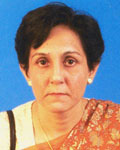full article:
Introduction
The Constitution of India has recognized certain ethnic groups and categorized them Scheduled tribes. They constitute approximately 8.2%1 of India's more than one billion population, and remain a greatly neglected group. Reproductive health among Scheduled tribes is considered a 'woman's affair'. The 1994 International Conference on Population and Development, held in Cairo, Egypt, and the 1995 Fourth Conference on Women, held in Beijing, China, the need to achieve gender equity for better reproductive health was stressed2,3.
Even a decade after such landmark conferences, men's involvement in reproductive health remains a new concept in India. Since 2000, two important documents, the National Population Policy (2000) and the Tenth Five Year Plan (2002-2007), have specifically mentioned the importance of male involvement in planned parenthood, promotion of male contraceptives and control of sexually transmitted infections (STI)/reproductive tract infection (RTI)4. However, Scheduled tribes remain untouched by whatever development has been achieved in the recent past.
Selected maternal and child health parameters for scheduled tribes of Central India
Madhya Pradesh is one of the poorest states in Central India and it accommodates the largest share (24%)5 of the Scheduled tribe population in the country. A look into the following maternal and child health (MCH) parameters of the Scheduled tribes from the National Family Health Survey (NFHS-2)6 data demonstrates how grave the situation is (Table 1).
Table 1: Key maternal and child health parameters
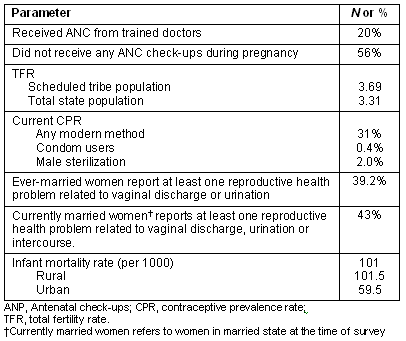
One limitation of these data are that they were generated by surveying ever-married females in the age group 13-49 years and lack information on men's reproductive health. There are no data on Scheduled tribe males' involvement in reproductive health and their problems. The present study is a small effort in this direction and pilots a process, using the Khairwar tribe, which can be replicated to understand other rural tribal groups. The main purpose of this study was to capture men's awareness, knowledge, attitude and the extent of their participation in different aspects of reproductive health.
Methods
Men's survey
A door-to-door survey was undertaken during the year 2002-2003. The sampling was purposive and an attempt was made to interview 260 currently married Khairwar men in the age group 15-40 years in the Sidhi district of the state of Madhya Pradesh in two blocks: Kushmi and Waidhan. Care was taken to interview only one male from each household. The issues covered in the interview schedule were identified from the local areas by personal discussion and group discussions with key respondents, usually village headman, local health workers, village teacher etc. Once the schedule was designed it was pre-tested in the field with a small sample of tribal men. The schedule was also checked by the National Institute of Medical Statistics (ICMR), New Delhi. The broad aspects covered in the interview schedule are summarized (Table 2).
Ethical clearance was obtained from Regional Medical Research Centre for Tribal's (RMRCT) ethical committee, and a consent form was attached to all interview schedules.
Table 2: Areas covered in the interview schedule

The study population and environment
In Central India, previously known undivided Madhya Pradesh, approximately 23.3% of its population are Scheduled tribes7. On 1 November 2000, the state was divided into Madhya Pradesh and Chhattisgarh and the proportions of Scheduled tribe population was 20% and 32%, respectively8. Khairwars are one of the poorer tribes of Madhya Pradesh and are considered a sub-group of the Gonds9 who are a numerically predominant tribe of Central India. The total population of Khairwars in the state of Madhya Pradesh was 62 90910 in 1999. Their exact population today is not available. They live in remote and inaccessible areas of the districts of Sidhi, Sarguja, Panna, Shahdol, Chattarpur, Satna, Rewa, Bilaspur and Raigarh11. The present study was restricted to the Sidhi district of Madhya Pradesh (Fig 1).
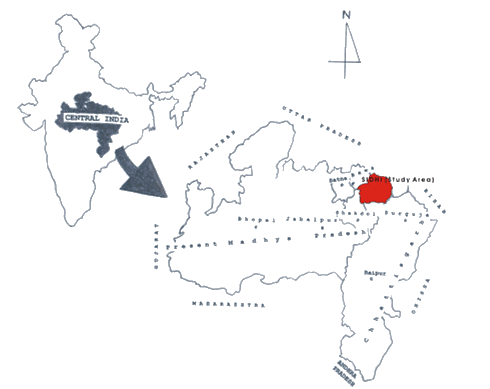
Figure 1: Map of undivided Madhya Pradesh in Central India, showing the study area.
Results and discussion
Basic characteristics of the household members and respondents
A total of 260 men agreed to be interviewed (52% response rate). The demographic characteristics of the interviewed sample are shown (Table 3). The Khairwar population is a young population with a sex ratio in favour of males. Approximately 69% of the males were found to be literate. Among the literates, most had studied up to class VIII standard.
Table 3: Basic household and respondents' characteristics
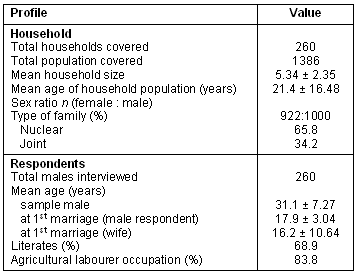
The survey results are shown (Fig 2). Approximately 74% of the Khairwar males had heard about RTI, but very few had proper knowledge of its transmission. Only 17% of the respondents had heard about HIV/AIDS and most of them did not have proper knowledge about its mode of transmission and prevention. Approximately 19% reported that there is no harm having sex with multiple partners.
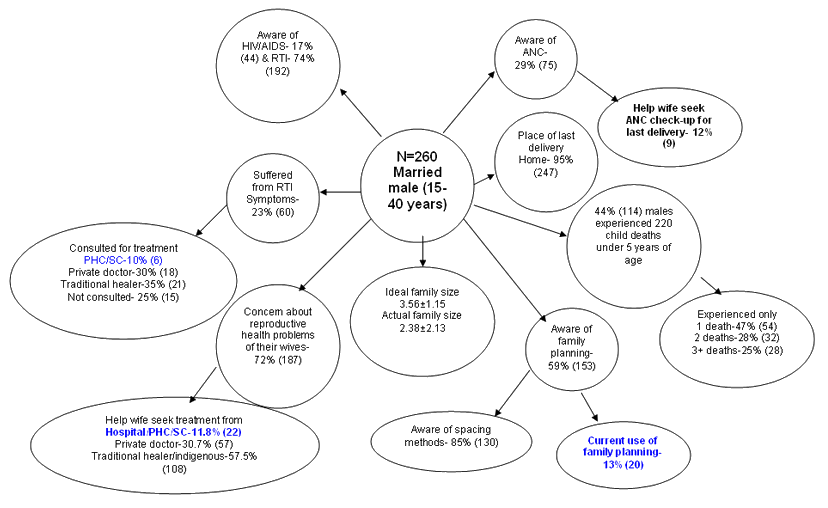
Figure 2: Basic survey results on reproductive health. The figures in parenthesis refer to frequencies and the figures in blue refer to utilization of government health services. ANC, Antenatal services; RTI, reproductive tract infection; PHC/SC, primary health care/sub centers.
The men sought assistance from health services only when their suffering become critical. Often this assistance was from untrained traditional medicine men. Their wives usually remained untreated for any such problems. Men were more exposed to sexual activities outside the home, particularly unsafe sex. Other studies have shown that this predisposes them and their wives to STI12,13.
Khairwar men avoid the use of family planning. Although 59% of the males had heard about one or more modern methods of family planning (eg female sterilization), only 13% were using them. They were unaware of the dual role of condoms in preventing STI and avoiding unwanted pregnancy. The tribal view was that men's major responsibility was to provide financially for their families, and that childbearing and contraception were the women's role.
The study also found that even though men avoided family planning, the methods used by the women were at the discretion of their husbands. This is similar to a study from Zimbabwe, where men reported making the final decisions in contraceptive use, even when women were responsible for obtaining contraceptives14. A number of other studies also demonstrate discordance within couples regarding contraceptive use15-22. The ideal number of children refers to respondents' hypothetical view of the number of children a Khairwar family should have. Among the Khairwar men, the ideal number of children (3.56 ± 1.15) exceeded the actual number of children born and living (2.38 ± 2.13). The preference for higher fertility among males may be a product of the cultural and economic value of children, and also a persistent insecurity about children surviving to adulthood, due to high infant and child mortality in the community. The men's choice for higher fertility overrules their wives' wishes.
Although men prefer a higher number of children, they take little action to ensure the safety of their wives during pregnancy and childbirth. Only 29% of the men had heard about antenatal care, and only 12% reported having helped their wives seek such services during their last pregnancy. Almost all deliveries (95%) were at home by untrained personnel.
The inaccessibility of health posts in remote areas, dissatisfaction with the Government health providers, availability of traditional medicine men, and a shortage of trained medical practitioners all contribute to the low utilization of government health services. There are no specific male reproductive health services available. The available reproductive health services in rural areas focus mainly on MCH services. There is a strong service need for male reproductive and sexual health clinics within primary health centers and sub-centers in rural areas.
Myths and attitudes towards sexual problem: Myths about masturbation, nightfall and unhelpful attitudes towards various sexual health matters were expressed by a number of respondents and are presented (Fig 3). About 18% of males believe that the women is responsible for the spread of reproductive health problems, and 18% prefer multiple sex partners during their wives' pregnancy. Such male attitudes towards sexual matters only lowers the esteem of women, further decreasing their opportunity to exercise choice in sexual health matters.
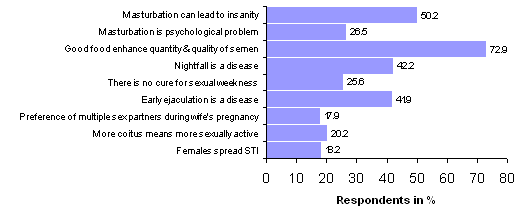
Figure 3: Attitude towards sexual problems (n = 263). STI, Sexually transmitted infection.
Conclusion
This study reveals that among the rural Khairwars population, a lack of knowledge of and misinformation regarding male sexuality, gender inequality, and a lack of male-oriented services deter men from sharing the responsibility in reproductive health matters.
In a patriarchal society, it is the male who makes major decisions, regulates the household economics and also imposes their views/choices on the females. Rural women cannot utilize even free, basic health services against their husbands' wishes. It is time to eliminate this gender inequality by empowering women through education, strengthening them economically, and creating grass roots level security arrangement against domestic violence, so that their word will be respected.
There is a need to adopt a comprehensive approach to reach men through health education. This health education should specifically highlight the vulnerable reproductive health of the females and the role men can play in improving their condition. Such a program should also include proximate contributors to health, such as gender equity and sustainable community development. There is also a need to strengthen the government health delivery system through appropriate training and motivation for doctors, paramedics and other village level health workers, on the different aspects of reproductive health in rural areas. There should be special incentives for working in rural and remote areas. Provision is required for counseling and treatment of both male and female reproductive health problems. Additionally, training the traditional medicine men and private health practitioners, who are popular in rural areas, on the diagnosis and treatment of minor reproductive health problems could assist. Female centred family welfare programs could possible expand to look at couples, rather then only females.
From this study it is evident that Khairwar men have a two-fold responsibility. First, they must be a supportive partner to their wife. Second, they must take care of their own unmet reproductive health needs. Although our suggested strategies have focused on the males, we believe that men and women can be equal agents of change for sustainable development. A stronger partnership between men and women means healthier families.
Acknowledgements
The authors sincerely acknowledge Professor Arvind Pandey, Director, National Institute of Madical Statistics (ICMR), New Delhi for his help in improving the study design and survey instrument. Acknowledgements are due to Dr AP Dash, Director, National Institute of Malaria Research (ICMR), New Delhi for his support. The authors also acknowledge Regional Medical Research Centre for Tribals (RMRCT), Jabalpur for providing the facility. Thanks are due to Dr DC Jain and Mrs Ujwala Das, Research assistant at RMRCT for providing help at the time of preparation of the manuscript.
References
1. Registrar General and Census Commissioner of India. Census of India 2001. (Online) no date. Available: www.censusindia.net (Accessed 30 March 2007).
2. National Institute for Research in reproductive Health (ICMR), UNDP/UNFPA/WHO/World Bank Special Programme of Research, Development and Research Training in human reproduction, CONRAD, USA and ISSRF Programme and Abstracts. In: Proceedings, International conference on men as a partners in sexual and reproductive health. 28 November to 1 December 2004; Mumbai, India, 2004.
3. Puri CP, Look PFAV. Sexual and reproductive health: recent advances, future directions, Vol 1. Mumbai: New Age International, 2001.
4. Khan ME, Panda P. Involving men in reproductive health in India: Policies, programs and achievements. The Journal of Family Welfare 2004; 50: 57-70.
5. Regional Medical Research Centre for Tribals. Glimpses of tribal health 85th anniversary. Jabalpur: Indian Council of Medical Research, 1996.
6. International Institute for Population Sciences. National Family Health Survey (NFHS-2) . Madhya Pradesh: MEASURE DHS & ORC Macro (USA), no date.
7. Saha KB, Verma A. High fertility among Scheduled tribes of Madhya Pradesh. Indian Journal of Medical Research 2006; 123: 89-90.
8. Census of India. Primary Census Abstract. (Online) 2001. Available: http://www.education.nic.in/ (Accessed: 30 March 2007).
9. Russell RV. The Tribes and Castes of the Central province of India Vol 3. Delhi: Low Price Publication, 1997.
10. Roy J.
11. Tiwari DN. Primitive tribes of Madhya Pradesh, stategy of development. Madhya Pradesh: Ministry of Home Affairs, Government of Madhya Pradesh, India, no date.
12. Davis KR, Weller SC. The effectiveness of condoms in reducing heterosexual transmission of HIV. Family Planning Perspectives 1999; 31: 272-279.
13. Dudgeon MR, Inhorn MC. Men's influences on women's reproductive health: medical anthropological perspectives. Social Science and Medicine 2004; 59: 1379-1395.
14. Mbizvo MT, Adamchack DJ. Family planning knowledge, attitude and practices of men in Zimbabwe. Studies in Family Planning 1991; 22: 31-38.
15. Becker S. Measuring unmet need: wives, husbands or couples? International Family Planning Perspectives 1999; 25: 172-180.
16. Bongaarts J, Bruce J. The causes of unmet need for contraception and the social content of services. Studies in Family Planning 1995; 26: 57-75.
17. Casterline JB, Perez AE, Biddlecom AE. Factors underlying unmet need for family planning in the Philippines. Studies in Family Planning 1997; 28: 173-191.
18. Casterline JB, Sinding SW. Unmet need for family planning in developing countries and implications for population policy. Population and Development Review 2000; 26: 691-723.
19. Klijzing E. Are there unmet family planning needs in Europe? Family Planning Perspectives 2000; 32: 74-81, 88.
20. Ngom P. Men's unmet need for family planning: implications for African fertility transitions. Studies in Family Planning 1997; 28: 192-202.
21. Wolff B, Blanc AK, Ssekamatte-Ssebuliba J. The role of couple negotiation in unmet need for contraception and the decision to stop childbearing in Uganda. Studies in Family Planning 2000; 31: 124-137.
22. Yebei VN. Unmet needs, beliefs and treatment seeking for infertility among migrant Ghanaian women in the Netherland. Reproductive Health Matters 2000; 8: 134-141.
(Article corrected on 23 May 2007. Ethical clearance: "was obtained from Xavier Institute" replaced by "was obtained from Regional Medical Research Centre for Tribal's (RMRCT)". Incomplete Figure 3 replaced.

